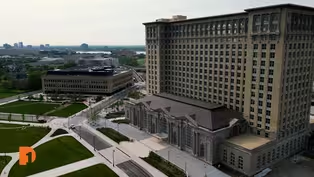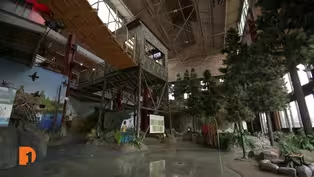
Ford Piquette Avenue Plant Museum preserves Detroit history
Clip: Season 9 Episode 1 | 5m 2sVideo has Closed Captions
The Ford Piquette Avenue Plant Museum is working to preserve Detroit’s automotive history.
The Ford Piquette Avenue Plant in Detroit’s Milwaukee Junction neighborhood is an integral part of the Motor City’s legacy, and it has been transformed into a museum to preserve its history. One Detroit’s Chris Jordan took a tour of the museum with its President and COO Jill Woodward to learn about the iconic collection of Detroit automotive history that sits within its walls.
Problems playing video? | Closed Captioning Feedback
Problems playing video? | Closed Captioning Feedback
One Detroit is a local public television program presented by Detroit PBS

Ford Piquette Avenue Plant Museum preserves Detroit history
Clip: Season 9 Episode 1 | 5m 2sVideo has Closed Captions
The Ford Piquette Avenue Plant in Detroit’s Milwaukee Junction neighborhood is an integral part of the Motor City’s legacy, and it has been transformed into a museum to preserve its history. One Detroit’s Chris Jordan took a tour of the museum with its President and COO Jill Woodward to learn about the iconic collection of Detroit automotive history that sits within its walls.
Problems playing video? | Closed Captioning Feedback
How to Watch One Detroit
One Detroit is available to stream on pbs.org and the free PBS App, available on iPhone, Apple TV, Android TV, Android smartphones, Amazon Fire TV, Amazon Fire Tablet, Roku, Samsung Smart TV, and Vizio.
Providing Support for PBS.org
Learn Moreabout PBS online sponsorship(upbeat music) - The Ford Piquette Avenue Plant is really one of the most important historic sites for the automotive industry in the world.
It is really the origin point of the Motor City.
So when we ask ourselves, you know, where did Detroit get its start as the Motor City, it happened right here in Milwaukee Junction.
This is one of the world's oldest surviving automotive factories.
And so we're just thrilled to be able to share it with the public.
This is sort of quintessential Detroit.
When you think about what's iconic to, say, Philadelphia, you think of, you know, Independence Hall in Boston.
You think of the Old North Church.
To us here, we think of the Ford Piquette Plant as completely iconic to the Motor City.
Henry Ford built the Ford Piquette Plant in 1904.
He was here until 1910.
And this is where he envisioned and built the very first Model T, which we know is the car that put the world on wheels.
We actually have Henry Ford's secret experimental room rebuilt here in the museum on the third floor.
And it's holy ground for a lot of people, to see the spot where that vehicle, the very first one, was made.
And we had an industrial archeologist come and help us rebuild that exhibit so it looks exactly as it did in Henry Ford's time.
And you gotta think, this vehicle went on to be in production for 19 years.
Over 15 million were made.
And when you come here, you can see, for instance, number 220 that was made right here in this building, that's our red Model T downstairs, in 1909.
The museum that you see today is the effort of several decades of volunteer labor.
We have dozens and dozens of volunteers.
But the museum that you see today really came together around 2017, when we accepted this very important collection of cars from the Porter Foundation.
We have over 65 very rare vehicles here, including one of the only collections of Henry Ford's letter cars, those are all the models leading up to the T that you can see anywhere in the world, in the place where they were made.
Henry Ford was interested in making lightweight, inexpensive cars for the everyday person.
All of his competitors at the time were making big, heavy, expensive cars.
So he really came up with the Model N, which was innovative for so many reasons, before the Model T. The Model N actually made him a millionaire, before the Model T. But by the time he gets to the Model T, he's really perfected ways to make cars lightweight, strong.
He transforms everyday life and sparks the movement from farms to factories.
I feel like we've lost a little bit the significance of Milwaukee Junction.
When we think about this neighborhood, you know, it just doesn't roll off the tongue, even for long-time, lifelong Detroiters.
But this is exactly where the Motor City got its start.
Right here.
Because of the railroads.
And the Erie Canal had just opened, and there were minerals coming down from Northern Michigan on the Great Lake steamships.
So much was happening here.
They were making stoves and carriages and bicycles.
So there was all that innovation and entrepreneurship happening that really set the stage for what Henry Ford was gonna do right here in this building.
There were over 25 manufacturers within a five-mile radius of this plant, where we're standing today.
So it's really hard to imagine the activity that would've been here.
Not just automakers, but also auto suppliers.
It was really the Silicon Valley of its day.
The museum is open from Wednesday through Sunday, from 10:00 AM to 4:00.
And we have optional guided tours at 10, noon, and 2, but I highly, highly recommend taking the docent tour.
Our docents are incredibly expert in their knowledge of all things Ford, Ford Motor Company, and early automotive history.
And it really is like stepping back in time with them through the information they impart.
When we think about Detroit and what it means to the rest of the world, I think our contributions are really summed up by places like this, that contain our history.
Our history that really went on to change the world.
The Model T really changed the way we live and drive today.
It enabled people a new level of freedom, to be able to leave their small-town neighborhood and travel across the country or the world.
Prior to that, people didn't really go beyond 25 miles of their home.
So the Model T was very freeing.
It was freeing for women.
Model T's took doctors and dentists across the country.
It opened up the national parks for camping, which Henry Ford and his friend Thomas Edison popularized.
The ramifications of this vehicle are just really untold.
So to have the birthplace of that vehicle here in Detroit preserved by chance and a lot of hard work is really a great gift.
CCH Pounder’s ‘Double ID’ exhibit at The Wright Museum
Video has Closed Captions
Clip: S9 Ep1 | 7m 11s | The Wright Museum opens the “Double ID” exhibit from actress and art collector CCH Pounder. (7m 11s)
Michigan Central Station reopens after historic renovation
Video has Closed Captions
Clip: S9 Ep1 | 5m 3s | Michigan Central Station reopens to the public after a six-year restoration process. (5m 3s)
Outdoor Adventure Center brings Michigan’s outdoors inside
Video has Closed Captions
Clip: S9 Ep1 | 4m 21s | Outdoor Adventure Center brings Michigan’s outside in to experience nature and recreation. (4m 21s)
Providing Support for PBS.org
Learn Moreabout PBS online sponsorship
- News and Public Affairs

Top journalists deliver compelling original analysis of the hour's headlines.

- News and Public Affairs

FRONTLINE is investigative journalism that questions, explains and changes our world.












Support for PBS provided by:
One Detroit is a local public television program presented by Detroit PBS


